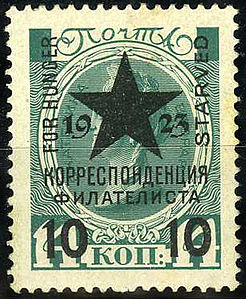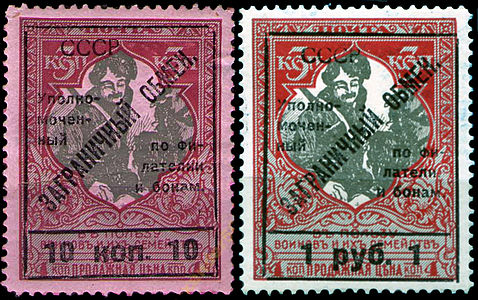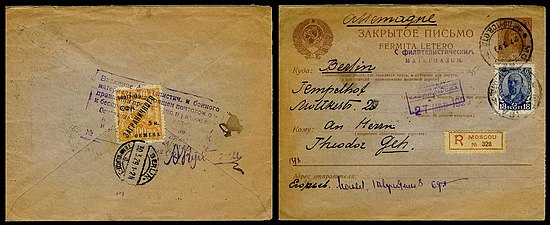
An overprint is an additional layer of text or graphics added to the face of a postage or revenue stamp, postal stationery, banknote or ticket after it has been printed. Post offices most often use overprints for internal administrative purposes such as accounting but they are also employed in public mail. Well-recognized varieties include commemorative overprints which are produced for their public appeal and command significant interest in the field of philately.
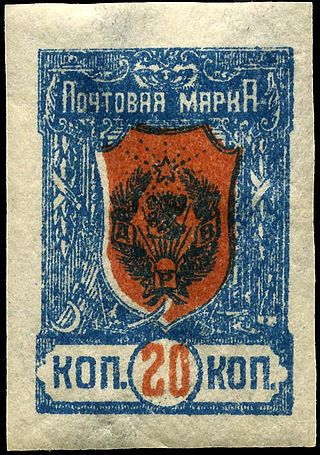
The Far Eastern Republic, sometimes called the Chita Republic, existed from April 1920 to November 1922 in the easternmost part of Siberia. It was formed from the Amur, Transbaikal, Kamchatka, Sakhalin, and Primorye regions. In theory, it extended from Lake Baikal to Vladivostok but, in May 1921, the Priamur and Maritime Provinces seceded. Although nominally independent, it was largely controlled by the RSFSR and its main purpose was to be a democratic buffer state between the RSFSR and the territories occupied by Japan during the Russian Civil War to avoid war with Japan. Initially, its capital was Verkhneudinsk, but from October 1920 it was Chita. On 15 November 1922, after the war ended and the Japanese withdrew from Vladivostok, the Far Eastern Republic was annexed by Soviet Russia.
This is a survey of the postage stamps and postal history of Transnistria, an unrecognized breakaway territory of Moldova and the de facto independent Pridnestrovian Moldavian Republic.

The postage stamps and postal history of Armenia describes the history of postage stamps and postal systems in Armenia. Czarist Russian postmarks and stamps were in used in the territory of Armenia from 1858. The early postmarks were composed of dots in different shapes. Dated postmarks with city names soon followed. Many counterfeit postmarks are known. From 1909 until 1918 a few Russian stamps were overprinted identifying the Armenian Post. The Armenian letters H & P are intertwined, representing the initials of hai post, the Armenian Post Office.

This is a survey of the postage stamps and postal history of Ukraine.

People's Commissariat for Posts and Telegraphs of the RSFSR, known shortly as the Narkompochtel, was the central organ of government of the RSFSR that was in charge of the organisation and development of the different forms of communication, including postal service. It was founded in Petrograd on 7 November [O.S. 25 October] 1917 from the Russian Ministry of Posts and Telegraphs and retained its organisational structure.

Raymond John Ceresa was an English chemist, stamp collector and philatelic expert on postage stamps of Russia and areas from the 1917–23 era. Ceresa wrote a five-volume monumental work on these issues.

All-Russian Society of Philatelists was the first national philatelic organisation in Soviet Russia established in 1923. Later on, it was subsequently renamed and reorganised into the All-Union Society of Philatelists and the All-Union Society of Collectors.
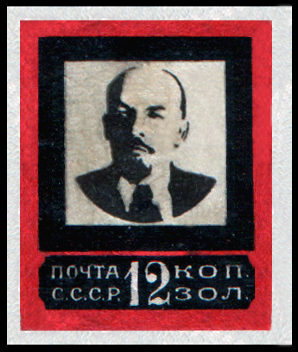
In philately, Leniniana is a topic for collecting postage stamps that tell about the life and story of Vladimir Lenin (1870–1924) or people, places, etc. connected with him. The topic was common in the Soviet Union.
Organisation of the Commissioner for Philately and Scripophily was established in Moscow in 1922 by the All-Russian Central Executive Committee (VTsIK) for matters concerned with philately and bonds. An old Bolshevik Feodor Chuchin headed this organisation.

Philatelic International (Filintern) was an international philatelic society of collector-workers. It was founded and based in the Soviet Union in the 1920s to 1940s.
Soviet Philatelic Association was a business run by the Soviet Union authorities in the field of philately.

Soviet Philatelist or Sovetskii Filatelist was a Soviet central philatelic magazine published in 1922–1932 by the All-Russian Society of Philatelists. For a number of years, in 1925 and in 1928–1932, its name was changed to Soviet Collector or Sovetskii Kollektsioner.

Filateliya (Philately) or formerly Filateliya SSSR is a Russian central philatelic magazine. It first appeared in 1966 as the monthly bulletin Filateliya SSSR and was issued by the USSR Ministry of Communications. The magazine content includes the history and design of postage stamps, and other related themes.

Kollektsioner or formerly Sovetskii Kollektsioner is a Russian central philatelic yearbook. This annual publication started in 1963 and covered the history and design of postage stamps, and other related topics.
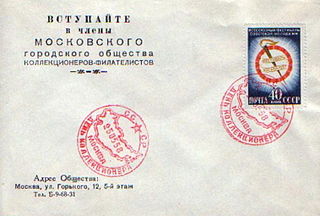
Moscow Municipal Society of Philatelists was a regional philatelic organisation in the Soviet Union established in Moscow in 1957. Later on, it was merged into the All-Union Society of Philatelists.

Russian Bureau of Philately was a special organisation under the People's Commissariat for Posts and Telegraphs of the RSFSR in 1921–1924. This was the first Soviet government agency in charge of all matters of the organisation and development of philately.

The Gold Standard issue or Small Head issue was the first definitive series of postage stamps issued by the Soviet Union between 1923 and 1927. The stamps were designed by Ivan Shadr.

Stamps of the Soviet Union were issued in the period 1923 to 1991. They were labeled with the inscription Russian: "Почта СССР". In the thematics, Soviet stamps reflected to a large extent the history, politics, economics and culture of this world's first socialist state.
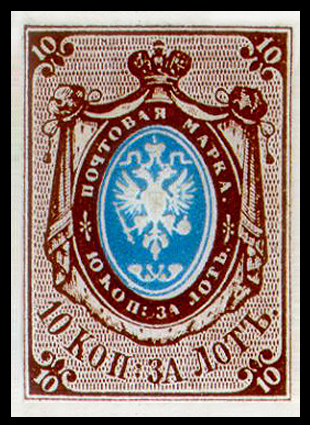
The first stamp of the Russian Empire was a postage stamp issued in 1857 and introduced within the territory of the Russian Empire in 1858. It was an imperforate 10-kopeck stamp depicting the coat of arms of Russia, and printed using typography in brown and blue.
![First RSFSR stamp [ru] of 1918 used with surcharge of 250 rubles by Posledgol as an international trading tax stamp in 1922 RSFSR CKPG stamp 1922 250r.jpg](http://upload.wikimedia.org/wikipedia/commons/thumb/a/a3/RSFSR_CKPG_stamp_1922_250r.jpg/160px-RSFSR_CKPG_stamp_1922_250r.jpg)


